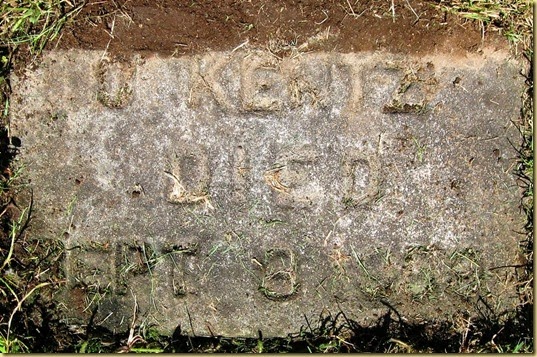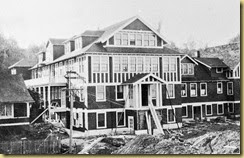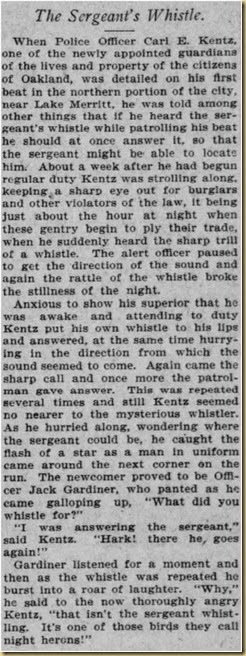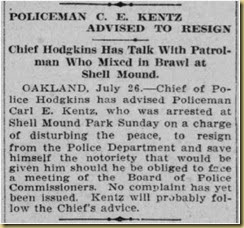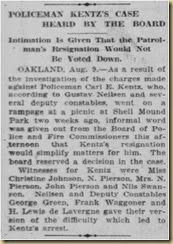THE MENTAL HEALTH SERVICES
of the
PROVINCE OF BRITISH COLUMBIA
By: Doctor A. M. Gee, Essondale, B. C.
Click on Chapter headings:
Provincial Mental Hospital, New Westminster, B.C.
Provincial Mental Hospital, Essondale, B.C.
Provincial Mental Hospital, Colquitz, B.C.
The Crease Clinic of Psychological Medicine
Homes for the Aged
Child Guidance Clinics
It will be my endeavor in this article to present to you an over-all picture of the Mental Health Services of the Province of British Columbia, but before proceeding to this I wish to give you some idea of the magnitude of the problem presented by mental illness, something of the general nature of mental illness, and finally the means of dealing with the problem of mental illness..
In Canada, as in other countries, mental illness takes a very heavy toll. Mental illness is not just a matter of sanity or insanity but rather has many gradations ranging from minor emotional disturbances to complete and total disability. In British Columbia, as in the other provinces, the number of patients in the mental hospitals is equal to the number of patients in all other hospitals from all other causes. There is in Canada at the present time a total of 50,000 patients in the mental hospitals, while in B.C. we have at the present time over 5,000 patients being treated and cared for in our mental hospitals.
In 1947, 13,085 of our citizens were admitted to the mental hospitals of Canada, while in the same year, 1,111 of our own citizens were admitted to the mental hospitals of B. C. Let us not over-estimate this admission rate, however, serious though it may be, but rather direct our attention to the data concerning discharges from the mental hospitals. Of the 1,111 patients admitted to the Provincial Mental Hospital in 1947 we were able to discharge 935, while in 1948 of the 1,260 patients admitted 1,193 were discharged to return to the community. Over half of those discharged, in 1948 were hospitalized for a period of less than 4 months duration.
The cost of maintaining Canada's 43 mental hospitals is in excess of 26 million dollars annually. It is generally conceded that one person in 20, will, during his lifetime, be a patient for a period in a mental hospital, and in addition it is estimated that one person in every ten suffers from some type of serious emotional disturbance at some time in his life history. From these few figures it is possible for one to gain a general impression of the magnitude which the problem of mental illness presents.
On the brighter side of the picture, however, I am pleased to be able to draw your attention to real progress in the field of Psychiatry. In the past few years the mental hospitals have turned increasingly from the simple custodial care of their patients to a program of active treatment and prevention. While the mental hospital still remains the focus of mental health care, the centre of gravity is gradually shifting from the mental hospital to the community where there are, at present, rapidly developing systems for treatment and prevention.
Let us now direct our attention to the general nature of mental illness. Many of you have no doubt thought of mental illness as something strange and remote from your lives, something entirely different from physical discomfort or disease. "Health” may be defined as that condition of the body in which all of the functions are performed normally. "Mental Health" "may be defined as the adjustment of individuals to the world and to each other with a maximum of effectiveness and happiness. In a broad sense this is a very good definition of democracy and we might say that Democracy and national mental health go hand in hand.
Physical health manifests itself inside of your skin. Mental health manifests itself outside of your skin, in your thinking, your feeling, and particularly in your doing and interpersonal relationships. "Mental Health" be further defined as the ability to maintain an even temper, an alert intelligence, socially considerate behaviour, and a happy disposition. Mental or ill health exhibits itself in how you react in regard to life and death, joy and sorrow, blame and praise, love and hate, and fear. All mental illnesses demonstrate disorders in the sphere of the emotions. If a person is able to handle his emotions in relation to those who live about him and be happy, he is mentally healthy.
I would now like to present to you for your better understanding the true parallel that exists between physical and mental health; physical and mental illness. There are certainly as many degrees of mental fitness as there are degrees of physical fitness. Few of us claim to be physically 100% fit all of the time and few of us reach middle age without carrying some minor or major physical disability which to a degree interferes with our ability to function at our maximum capacity. Some of us suffer from minor disabilities which may incapacitate partially or wholly for a short period. Others again suffer from time to time from major disabilities from which we may or may not recover. Again, we have a group of physical diseases which require long periods of active treatment with partial recovery or arrest of the progress of the disease leaving a definite disability and a permanent limitation of function. Such a disease is tuberculosis.
In the realm of mental disease we have exactly the same situation. We all suffer at times from minor emotional discomforts or disabilities. Some of us suffer from more severe mental reactions which may incapacitate us for a time and which require hospital treatment but from which complete recovery is certain. Again, others will suffer from mental symptoms similar in severity to tuberculosis and for this a longer period of hospitalization and treatment will be required with a good outlook for arresting the progress of the disease.
In this mental illness, however, the patient will in all probability never again regain his efficiency 100% and like the arrested tubercular patient will need assistance in rehabilitation and in reorienting himself toward his life situation.
There are indeed as many disabling conditions in psychiatry as there are in general medicine and a true parallel exists between mental symptoms and physical symptoms, mental disease and physical disease. By following this close parallel we should be able to avoid the senseless, shameful notion that mental illness carries with it some social stigma. I would like to pursue this parallel just a little further in order that you may see how the various mental health services are grouped at the active treatment level.
Physical disorders of all types may be classified under the following headings:
1. Developmental defects - i.e.,congenital disabilities.
2. Organic illnesses - (including injuries).
3. Functional illnesses.
4. Infective or toxic illnesses.
5. Degenerative illnesses.
6. Public health - (preventive medicine).
Mental disorders of all types may be classified similarly as follows:
1. Developmental defects - i.e., mental deficiency and subnormality.
2. Organic mental illnesses - (including injuries).
3. Functional mental illnesses.
4. Toxic central illnesses.
5. Degenerative mental illnesses.
6. Mental hygiene - (preventive psychiatry).
In accordance with the categories set forth above our active mental hospital treatment service naturally breaks down into four main divisions.
1. Treatment and education of the subnormal.
2. The treatment of the acutely mentally ill - organic, functional, toxic psychoses (psychotic patients).
3. The treatment of those suffering from degenerative train conditions (senile, arteriosclerotic).
4. Preventive services.
Return to Index
Provincial Mental Hospital, New Westminster, B.C.
This unit of the Provincial Mental Health Services functions as a training school for the mentally defective and at the present time has a patient population of 653 with no vacant beds. The function of this unit is, of course, the training of the mentally subnormal with the objective being to develop the individual to his maximum capacity. At this hospital there is a modern, five room special school which is staffed by seven fully qualified teachers. As part of the school there is a well equipped gymnasium and auditorium as well as special classrooms designed for the teaching of domestic science and the manual arts. In the program of this school considerable emphasis is placed upon the socialization of the children, employing recreational and social activities in this part pf the training program.
At the present time there is a program or expansion underway at the Provincial Mental Hospital, New Westminster, B. C., consisting of four modern type buildings each of which will have a capacity of approximately 100. It is hoped that the provision of these new buildings will make it possible to relieve some of the over-crowding and also to admit some of the patients who are presently of necessity kept on the waiting list until a bed becomes vacant.
Out of the total population of 653 patients, 140 are participating in the academic training school program. The teaching staff endeavours to provide a special teaching program to meet the individual needs of the population rather than to follow definite grade levels. In addition to the academic program great stress is laid on the teaching of domestic science and manual arts. Cooking, food preparation and serving are, stressed along with sewing, mending, and needle work. In the boys’ division opportunities are provided for the teaching of manual arts and for the older boy there is ample opportunity for learning the various industrial skills and trades associated with the operation and maintenance of the hospital plants.
Return to Index
Provincial Mental Hospital, Essondale, B.C.
This hospital is the largest unit of the Mental Health Services of the Province. It functions as the administration centre and headquarters in both medical and business administration. At the present time it is the admitting centre for all branches and all in-patients are admitted there and are transferred to other units. The first building was opened to receive patients in 1913. The Essondale unit has increased in capacity and size until at the present time it houses in excess of 3,600 patients. Consideration is being given now to the development of an entirely new hospital site to provide the increased care that will be required in the near future. The Mental Hospital at Essondale is classified by the American Hospital Association as a class A hospital. It is in all respects a fully modem hospital with excellent facilities for clinical investigation, diagnosis and treatment of all mental end neurological conditions.
In addition to medical and surgical facilities it offers the advantage of all accepted forms of psychiatric therapy. The occupational therapy program is well advanced, while the pioneering of our recreational therapy program has brought much credit to the Province of British Columbia.
Treatment within the hospital breaks down into,
(1) early and active treatment of the acutely mentally ill with a view to early recovery and rehabilitation;
(2) continued treatment for a large group of patients who will require a prolonged treatment period.
The Social Service Department is actively engaged in working with both of these classes of patients. The Psychiatric Social Service staff numbers ten and a representative of the department visits in the home of all patients admitted from the local area. Representatives of the Welfare Field Service visit in all other areas of the Province. Histories are submitted covering all contacts and activities of the patient in an endeavour to provide a longitudinal section of the individual's life in order that the psychiatrist may have understanding into all of the situational factors bringing about the illness. The individual social service worker keeps in constant touch with the patient during the hospitalization, and acts as liaison between the hospital and the home. Rehabilitation plans are worked out between the psychiatrist and the social service worker end after discharge of the patient further assistance and supervision is provided for him during the initial six month post-discharge period. To further assist in the rehabilitation of women patients a small home unit is maintained in Vancouver where the recovered patient may live a normal, unrestricted home life until she is able to find employment and be self-supporting.
Return to Index
Provincial Mental Hospital, Colquitz, B.C.
A small continued treatment unit is located at Colquitz, Vancouver Island, housing some 287 male patients. There is no direct admission to this hospital, all patients in residence having been transferred from the hospital at Essondale. The Provincial Mental Home offers complete medical and psychiatric care along with a full program of occupational and recreational activities. Future plans call for the construction of a complete new mental hospital adjacent this site to serve the needs of Vancouver Island and adjacent islands.
Return to Index
The Crease Clinic of Psychological Medicine
This is a new fully modem building to house 325 patients. It is an-active treatment and teaching centre, bringing active treatment to the Patient suffering from the early symptoms of mental Illness in which recovery and rehabilitation may be anticipated within a four month period. The Clinic of Psychological Medicine is a distinct advance from the usual mental hospital type of treatment and is a step closer to the community and general hospital type of care. The clinic houses group specialties representing all branches of medicine, surgery and psychiatry, as follows:
1. Complete x-ray department covering all phases of radiology, including an x-ray surgical suite and special apparatus for cranial and brain studies.
2. Complete clinical laboratories equipped to carry out all types of clinical laboratory investigation, teaching and research.
3. A department of cardiology for the investigation of the heart and cardiovascular system together with instruments for the determination of basal metabolic rate.
4. A complete eye, ear, nose and throat department.
5. A complete neurological department with facilities for electroencephalography.
6. A department of physical medicine which includes all forms of physiotherapy and hydrotherapy and electrotherapy.
7. A modern surgical suite for both general surgery and neurosurgery.
8. A department of psychiatry covering all accepted forms of psychotherapy.
9. A department of occupational therapy with division for male and female patients and providing the necessary apparatus and instructors for a wide range of interesting crafts.
10. A department of recreational therapy staffed and equipped to provide recreational activities to suit the needs and interests of all age groups.
11. A library, housing standard and more popular current works of fiction, under the supervision of a fully qualified librarian.
12. Complete facilities for teaching and lecturing.
The Clinic operates under a separate act of the Provincial Legislature, separate and apart from the Mental Hospitals Act, This new act provides for the admission of voluntary patients who may themselves terminate their hospitalization at will. Otherwise it provides for the admission of patients on the certificates of two medical practitioners without any legal certification or loss of competency on the part of the patient. The maximum period of hospitalization during which the patient may be retained is four months. It is believed that this new intensive approach to the treatment of mental illness will bring psychiatry closer to other branches of medicine and, will do much to gain the confidence of the population in seeking early advice in such matters. It should do much to place mental illness on the same plane as physical illness and help to remove any stigma which uninformed people may have regarding sickness of the mind.
Return to Index
Homes for the Aged
British Columbia was the first province to set up separate institutions for the psychiatric care of those aged individuals whose aging symptoms are predominately in the mental sphere. These buildings are of special design to meet the problems of caring for the aged. They are two storey, fireproof units with special ramps replacing all stairways. The grade of the ramp is such that it will permit comfortable walking as well as the use of a wheelchair or stretcher. Front entrances are ramped to spacious lawns for outdoor activities. All floor space including ramps is indirectly lighted by coved lighting at floor level. All ramps and corridors are provided with handrails. This type of building has received favorable comment from visitors from all points of the world.
The care of our aging population is rapidly becoming one of the major considerations at the present time. Chief reasons for the increased proportion of the aged in our population at this time are the great advance in medical and surgical care which have prevented death at an early age and increased the average life span. Two thousand years ago the average life span was approximately 25 years. In 1900 the average life span was 49 years, while in 1950 it is 66 ½ years. In 1900 one person in 25 was 65 years of age or older. It is estimated that by 1980 one person in 10 will be 65 years of age or over. Individuals now reaching superannuation age at 65 can look forward to an additional 12 ½ years of life. Unfortunately there is a considerable lag in the prevention and treatment of many of the degenerative diseases associated with the aging process, and particularly in this so in reference to those degenerative diseases producing mental illness in the aged. Much is needed in the way of research into this particular problem.
British Columbia has set up homes for the aged at Port Coquitlam where some 380 patients are housed and at Vernon, B. C. where some two years ago a new unit was opened to care for approximately 250 patients. In the near future it is expected that a third group of units will be opened in northern B. C. to serve the residents of that area.
The foregoing paragraphs have presented a survey of all the facilities for the "in care" of patients suffering from mental illness as operated by the Provincial Government. I would now like to direct your attention to the second aspect of psychiatry which is the preventive or mental health aspect.
Psychiatry was born put of jails, almshouses, and superstition and consequently has had to struggle to establish itself as a scientific practice. Even more difficult has been the establishment of sound principles of mental health. General public health measures can be applied to whole communities. Legislation may be enacted to insure a safe water supply and thereby eliminate many diseases. Living conditions may be improved. There are still, however, many people who dislike being told that they have to drink chlorinated water or that they may use only pasteurized milk, or that they must make provision against the day when they may need hospital care. In spite of these difficulties, by a process of public education it is still possible to deal with people in masses in matters of public health. Psychiatry and mental health, on the other hand, are largely matters of personal tutoring and individual education. In the not too distant past the psychiatric institution was separate and apart from the community. The psychiatrist was little more than the keeper of the keys and seldom emerged from his walled abode. Today we are trying to operate mental hospitals that are worthy of the name. We are now trying to move closer into the community and give service at the community level so that it will not be necessary to remove our patients from their community environment to an isolated mental hospital situation.
Return to Index
Child Guidance Clinics
In the matter of prevention, it is therefore only natural that we should turn our attention to children and their parents. From the school system we are able to contact children in large groups. In 1934 we were able to set up our first Child Guidance Clinic unit. This unit consisted of a psychiatrist, a psychologist, a nurse, a psychiatric social worker and a stenographer. This basic pattern is still followed in the staffing of the clinics. The purpose of the Child Guidance Clinic is to help normal children who are presenting problems in behaviour, social adjustment, or education. Children may be referred to the clinic from the school or any social agency, the physician or the parents. There are at the present time four clinic units functioning in B.C., as follows:
One Stationary Clinic, Vancouver
One Stationary Clinic, Vancouver - working with the Juvenile Court,
Boys’ and Girls’ Industrial Schools and the Borstal School.
One Traveling Unit, Vancouver
One Stationary Unit, Victoria.
In addition, the Metropolitan Health Board in Vancouver operates a Division of Mental Health with a similar type of unit functioning in the school. A second such unit is now being formed under the auspices of the City Health Services at Victoria.
To further radiate into the school system a pilot group of teachers is being trained to act as mental health coordinators. Already two such teachers have completed the one year of training at the University of Toronto, one being stationed in the Victoria schools and one in the Vancouver schools. At the present time two more teachers are undergoing a similar course of training.
The last link in the chain stretching from the mental hospital to the community is now being forged in the formation of the Canadian Mental Health Association with headquarters at Toronto. This mental health association is being developed under the guidance of Dr. Clarence M. Hincks, an outstanding Canadian psychiatrist who has devoted a lifetime to promoting improved standards in mental health care. It is planned to set up Provincial headquarters in each province and to have similar units formed in each community. In the future you will be hearing more of the plans of the Canadian Mental Health Association.
Return to Index


